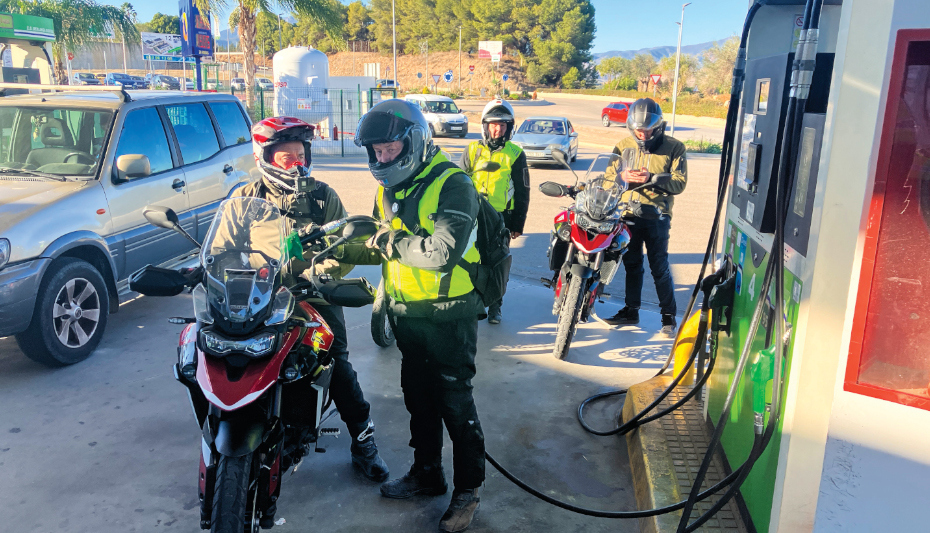High octane fuel isn’t always the best.
A common misconception about a fuel’s octane rating is its relation to power; many people believe that the higher the octane, the more power the fuel will produce. However, the grade of gas you put into your tank is entirely dependent on the type of engine in your bike. Using premium gas in an engine that doesn’t need it is unnecessarily costly, and it may even be detrimental to performance.
Physics dictates that the more a gas is compressed, the more heat it will generate. This also occurs when a fuel mixture is compressed by a rising piston, since a large volume of air and fuel is squeezed into a tiny space prior to ignition; the smaller the space, the higher the compression. The more a fuel mixture is compressed, the quicker and more completely it will burn; the higher the effective compression, the more energy that can be released from a given quantity of fuel. This is why high-performance engines have high compression ratios.
A spark plug ignites the compressed mixture and produces a flame front that works its way through the combustion chamber — ignition isn’t an explosion, but rather, a controlled burn. The plug is timed to fire early enough that combustion reaches peak pressure just as the piston begins its downward stroke, thus maximizing the efficiency of the burn.
But if a mixture is compressed enough (thus generating a lot of heat), it can also self-ignite elsewhere in the combustion chamber, which produces two flame fronts. The separate pressure waves from these flame fronts pound against the combustion chamber and cause a condition known as engine knock, or detonation; this sounds like a couple of steel balls rattling in a can.

A high compression ratio alone does not determine an engine’s tendency to knock. Another factor is cylinder bore. Larger bores require more time for the flame front to burn across the combustion chamber, which allows more time for the fuel mixture to detonate. This is why larger-bore engines generally have lower compression ratios.
One factor that can reduce knock is cam timing. Aggressive cam timing reduces the effective compression ratio — the longer the intake valves stay open, the later the piston begins compressing the mixture. This is why high-performance engines can get away with higher compression ratios. Also, air is less dense at higher elevations, therefore there’s less air to compress, which generates less heat and reduces the risk of detonation.
Detonation is not to be confused with pre-ignition, which is the result of hot spots in the combustion chamber, like carbon deposits. Hot spots can ignite the fuel before the spark plug fires. Sustained detonation or pre-ignition can lead to serious engine damage.
Gasoline contains additives that inhibit its ability to detonate (it used to be tetra-ethyl lead, but less-toxic chemicals like ethanol are now used). A gasoline’s resistance to detonation is indicated by its octane rating; the higher the number, the more it resists detonation.
The Research Octane Number (RON) is achieved by simulating light loads, like city driving or highway cruising, and provides the highest octane number. The Motor Octane Number (MON) simulates extreme conditions, like hard acceleration or driving uphill, and provides the lowest number. The Anti-Knock Index (AKI) is an average of those two and is what you see displayed as (R+M)/2 at the pump. Typical AKI grades that you’ll find at the pump are 87 (regular), 89 (mid-grade), and 91 (premium). Mid-grade fuel is a blend of low- and high-octane fuel.

However, to achieve a high-octane rating, the maximum allowable percentage of ethanol may be blended into fuel, or up to 10 per cent by volume. Ethanol has very good anti-knock properties, so it is often used in high-octane fuels, but it also lowers the fuel’s energy content. According to Natural Resources Canada, gasoline with a 10 per cent ethanol blend contains about 97 per cent the energy of pure gasoline. Aside from reducing power, ethanol can also increase fuel consumption by two to three per cent.
The main reason manufacturers recommend high-octane fuel in high-performance bikes isn’t because the fuel has more energy content; it’s to prevent knocking. There’s no advantage to using a higher octane than recommended in a bike that doesn’t require it. However, if you own an older bike, the recommended low-octane fuel may no longer be effective at preventing knock because of excessive carbon buildup and a lack of modern anti-knock devices. So, if you hear that characteristic rattling, fill up with a higher grade at your next fuel stop.













